The FDA has struggled with the best methods to determine the bioequivalence of topical dermatological drug products for years. For example, FDA considered numerous methods including transepidermal water loss (TEWL), skin stripping, and others to demonstrate the bioequivalence of retinoid acne products. None were found acceptable and the Agency ultimately relied on bioequivalence studies with clinical endpoints to approved generic versions of these cream, gel and ointment products.
The Agency continues to search for other more sensitive, validated methods to evaluate topical products such as semi-solids and transdermal systems that may better predict the bioequivalence of generic and reference listed drug products. If such methods could be developed, they may serve to provide a higher degree of confidence in FDA approval decisions and provide methods other than in vivo testing to support both generic drug approvals or changes to innovator products without exposing patients to additional, unnecessary exposure to the products.
In that regard, on April 12, 2018, FDA announced the following two new requests for study:
- Request for Applications: Formulation drug product quality attributes in dermal physiologically-based pharmacokinetic models for topical dermatological drug products and transdermal delivery systems (U01)
- Request for Applications: Characterize skin physiology parameters utilized in dermal physiologically-based pharmacokinetic model development across different skin disease states (U01)
The complete description of the requests can be found here and here. These requests are part of the FDA’s GDUFA Regulatory Science Research Program seeking to advance the science behind FDA approval decisions and to further explore methods to establish bioequivalence for complex products and thus speed generic products to market or permit change in existing product to be better understood.




